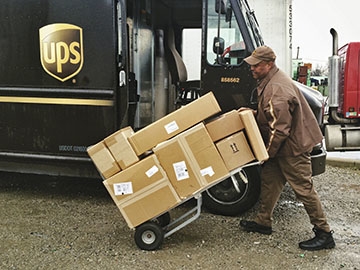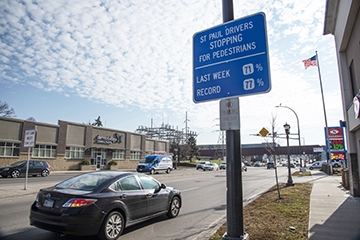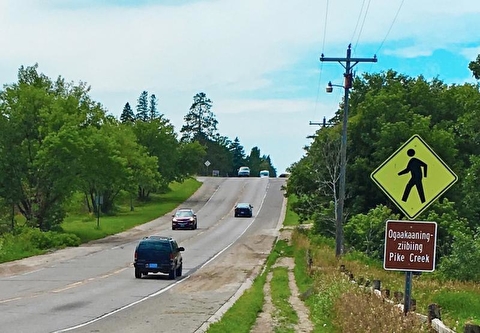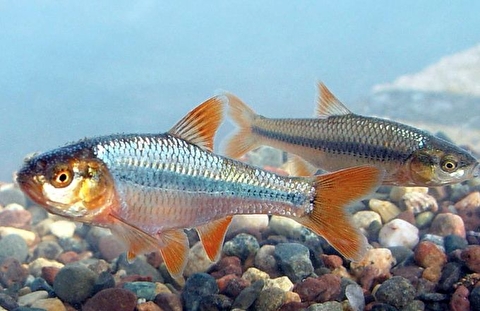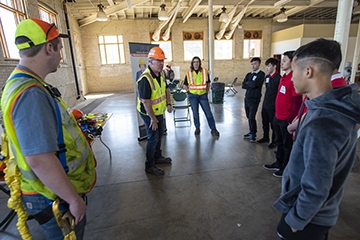Increased fuel efficiency — lower delivery costs
A research team is developing and deploying technology that will improve the fuel efficiency of package delivery vehicles.
Large delivery companies such as UPS use analytics to assign routes to minimize fuel consumption. Current UPS routing algorithms use historical data and do not interact directly with vehicles on the road.
The U of M team is integrating new technology into UPS electric powertrain vehicles to allow them to make adjustments in real time. The upgrades will connect vehicles to the “cloud” to feed route analytics. They will also enable the powertrains to respond to changing conditions such as weather and traffic. The project may improve fuel economy by more than 20 percent over the baseline electric vehicle now in the UPS fleet.
Lead researcher: Will Northrop, Mechanical Engineering. Co-investigator: Shashi Shekhar, Computer Science and Engineering. Sponsor: US Department of Energy.
“The increased fuel efficiency from this research may help delivery firms control costs, which benefits their customers, too.” — Mike Muldoon, telematics technical lead, Workhorse Group, Inc.
Learn more:
- “More fuel efficiency, less anxiety: research finds way to extend range of plug-in hybrids,” CTS Catalyst, October 2019
Safer drivers — safer pedestrians
Researchers in the University’s HumanFIRST Laboratory collaborated with city and state officials on a project aimed at reminding drivers to watch out for pedestrians. The team looked at several ways to improve Saint Paul’s existing pedestrian safety campaign, including low-cost engineering changes.
At eight test sites treated during the study, the researchers installed feedback signs that displayed the weekly percentage of drivers who stopped for pedestrians. Other signs reminded drivers that it’s Minnesota law to stop for pedestrians in crosswalks. The average compliance rate of drivers jumped from approximately 32 percent to as high as 78 percent.
Lead researcher: Nichole Morris, HumanFIRST Laboratory, Mechanical Engineering. Co-investigators: Curtis Craig, Mechanical Engineering, and Ron Van Houten, Psychology–Human Factors, Western Michigan University. Sponsor: MnDOT.
“The awareness of pedestrian safety grew to a new level.” — Commander Jeremy Ellison, Saint Paul Police Department
Learn more: “Researchers target driver behavior to improve pedestrian safety,” CTS Catalyst, December 2018
Community engagement — informed decisions
The motor vehicle crash fatality rate is higher for American Indians and Alaska Natives than for any other ethnic or racial group. Researchers sought to better understand and identify potential ways to reduce this high rate in tribal lands.
In their work, researchers collaborated with American Indian communities to learn the top roadway safety concerns and priorities. They also identified successes and limitations of existing efforts. One major finding: Pedestrian safety is a critical, distinctive, and under-recognized priority.
Researchers also assessed pedestrian safety at four reservations and monitored pedestrian traffic and highway crossings at 10 locations. They then developed recommendations for safety countermeasures such as crosswalks.
Lead researchers: Kathy Quick and Greg Lindsey, Humphrey School of Public Affairs. Sponsors: CTS, Roadway Safety Institute.
“We used the research findings to secure state funding for a new crosswalk and pedestrian-activated signal.” — Mike Moilanen, director of planning and project management, Mille Lacs Band of Ojibwe
Learn more: “U research on tribal transportation safety showcased in DC,” CTS Catalyst, June 2019
Practical culvert designs — healthier streams
Researchers developed a comprehensive culvert design guide to help preserve stream connectivity and promote the safe passage of fish and other aquatic organisms. The designs integrate environmental health with goals for public safety and infrastructure resilience and longevity.
Because of the variety of ecological regions in the state, the range of culvert geometries, and other factors, no single solution can work for culverts statewide. The new guide fills this information void.
Lead researcher: Matt Hernick, St. Anthony Falls Laboratory. Co-investigator: John Nieber, Bioproducts and Biosystems Engineering. Sponsors: MnDOT, Minnesota Local Road Research Board.
“This design guide offers a practical, Minnesota-based perspective on how to design culverts.” —Nicole Bartelt, MnDOT Bridge Office
Learn more: “New guide makes designing environmentally friendly culverts easier and more efficient,” CTS Catalyst, May 2019
Commuting choices — less congestion
The ABC Parking Ramps in Minneapolis were designed to ease congestion by encouraging carpooling and transit use. Now, however, they are increasingly used by solo drivers and surrounded by congested streets. A U of M team analyzed the issues and made recommendations to policymakers for the short and long term.
Options included a discounted daily rate for occasional carpoolers and flexible contracts with both ramp access and transit options. The researchers also advised adding more drop-off and pick-up areas for ridesharing and more charging stations for electric vehicles.
Lead researcher: Frank Douma, Humphrey School of Public Affairs. Co-investigators: Yingling Fan, Jason Cao, and Adeel Lari, Humphrey School. Sponsor: MnDOT.
“Based on the study, MnDOT changed ramp rates and programs to give Minneapolis commuters the flexibility to choose their travel mode daily and save money.” —Lisa Austin, MnDOT ABC Ramps and Mobility Hubs program manager.
Learn more: “Research team recommends policy changes for Minneapolis ABC Ramps,” CTS Catalyst, September 2018.
New experiences — promising career paths
More than 100 students from five high schools got an up-close, hands-on look at transportation construction jobs during MnDOT Construction Career Day at the State Fairgrounds. The new event raised awareness of career opportunities within the transportation industry. Students rotated in small groups through nine demonstration stations focused on highway heavy construction. Representatives from several MnDOT offices, contracting and consulting firms, and trade unions offered insight, encouragement, and practical advice.
Sponsor: MnDOT Office of Civil Rights.
“This has been an extremely valuable event to me personally. Not every kid is going to be able to get out here and see this, and that’s honestly, I think, why a lot of kids just don’t really get the jobs that they want.” — Cole, a Roosevelt High School student interested in carpentry
Learn more: “High school students dig into transportation construction careers,” CTS Catalyst, July 20
